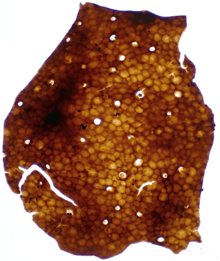Nematophyta
| Nematophyta Temporal range: Cambrian–410[1] | |
|---|---|
 | |
| Cuticle of Cosmochlaina, retrieved from the Burgsvik beds by acid maceration. Cells about 12 μm in diameter. | |
| Scientific classification | |
| Kingdom: | Plantae (?) |
| Phylum: | Nematophyta Lang, 1937[2] |
| Genera | |
|
Family Nematothallaceae:
Family Nematophytaceae:
| |
The Nematophyta or nematophytes are a paraphyletic group of land organisms, probably including some plants as well as algae[4][5] known only from the fossil record, from the Silurian period until the early Devonian Rhynie chert.[6] The type genus Nematothallus, which typifies the group, was first described by Lang in 1933,[2] who envisioned it being a thallose plant with tubular features and sporophytes, covered by a cuticle which preserved impressions of the underlying cells. He had found abundant disaggregated remains of all three features, none of which were connected to another, leaving his reconstruction of the phytodebris as parts of a single organism highly conjectural. No reproductive or vegetative structures common to the land plants are known,[7] and certain members of the nematophyte plexus (including Nemataplexus, axial conjugations of banded and branching tubes) seem to belong to the fungi.[8]
The lack of a clear definition of the nematophytes has led to it being used as a wastebasket taxon, with all manner of tubes and cell-patterned cuticles from around the Silurian being dubbed "nematophytic" more as a statement of ignorance than as a scientifically meaningful statement.
Nematophytes, including cuticle and banded tubes, have been found in coprolites that were apparently produced by millipedes.[9]
References
- ↑ Graham, L.; Wilcox, L.; Cook, M.; Gensel, P. (2004). "Resistant tissues of modern marchantioid liverworts resemble enigmatic Early Paleozoic microfossils". Proceedings of the National Academy of Sciences of the United States of America. 101 (30): 11025–11029. Bibcode:2004PNAS..10111025G. doi:10.1073/pnas.0400484101. PMC 503736
 . PMID 15263095.
. PMID 15263095. - 1 2 Lang, W. H. (1937). "On the Plant-Remains from the Downtonian of England and Wales". Philosophical Transactions of the Royal Society B. 227 (544): 245–291. Bibcode:1937RSPTB.227..245L. doi:10.1098/rstb.1937.0004. JSTOR 92244.
- ↑ Included in the Nematophyta by Taylor, W. A.; Wellman, C. H. (2009). "Ultrastructure of Enigmatic Phytoclasts (Banded Tubes) from the Silurian-Lower Devonian: Evidence for Affinities and Role in Early Terrestrial Ecosystems". PALAIOS. 24 (3): 167–180. doi:10.2110/palo.2008.p08-046r.
- ↑ Smith, M. R.; Butterfield, N. J. (2013). "A new view on Nematothallus: Coralline red algae from the Silurian of Gotland". Palaeontology. 56 (2): 345–357. doi:10.1111/j.1475-4983.2012.01203.x.
- ↑ Niklas, K. J. (1976). "Chemical Examinations of Some Non-Vascular Paleozoic Plants" (PDF). Brittonia. 28 (1): 113–137. doi:10.2307/2805564. JSTOR 2805564.
- ↑ Fayers; Trewin, Nigel H. (2003). "A review of the palaeoenvironments and biota of the Windyfield chert". Transactions of the Royal Society of Edinburgh: Earth Sciences. 94 (4). doi:10.1017/S0263593300000729.
- ↑ Strother, P.K. (1988). "New Species of Nematothallus from the Silurian Bloomsburg Formation of Pennsylvania". Journal of Paleontology. 62 (6): 967–982. JSTOR 1305385.
- ↑ Edwards, D.; Axe, L. (2012). "Evidence for a fungal affinity for Nematasketum, a close ally of Prototaxites". Botanical Journal of the Linnean Society. 168 (1): 1 –18. doi:10.1111/j.1095-8339.2011.01195.x.
- ↑ Edwards, D.; Selden, P. A.; Axe, L. (2012). "Selective Feeding in an Early Devonian Terrestrial Ecosystem". PALAIOS. 27 (7): 509. doi:10.2110/palo.2011.p11-094r.
- McGregor and Narbonne (1978): "Upper Silurian trilete spores and other microfossils from the Read Bay Formation, Cornwallis Island, Canadian Arctic"